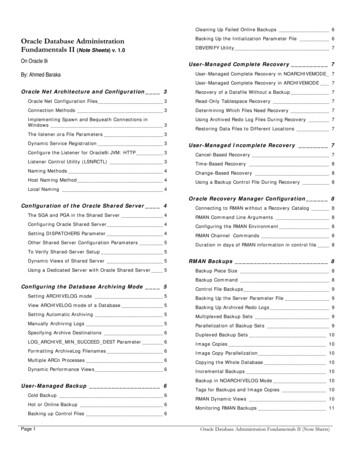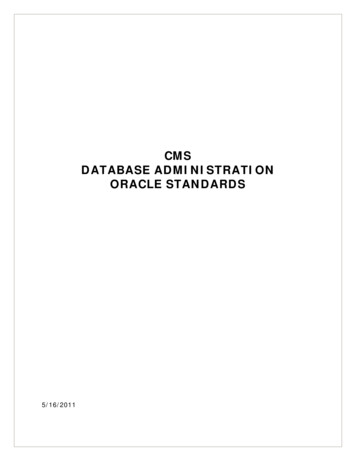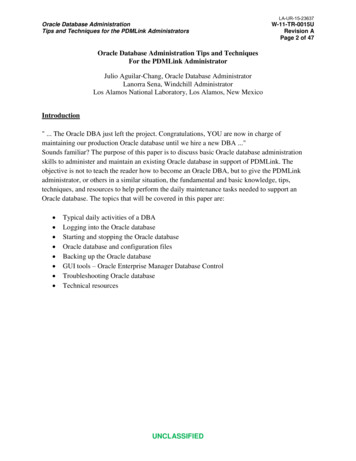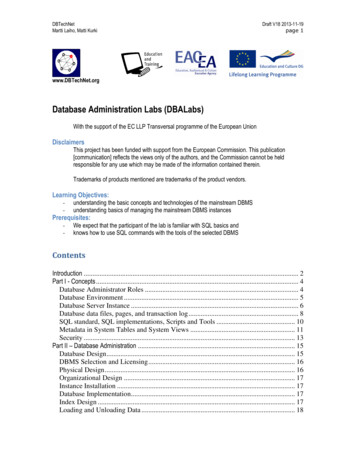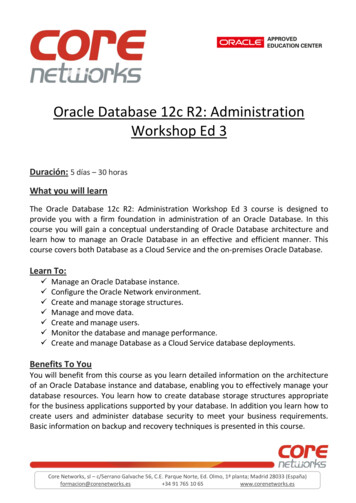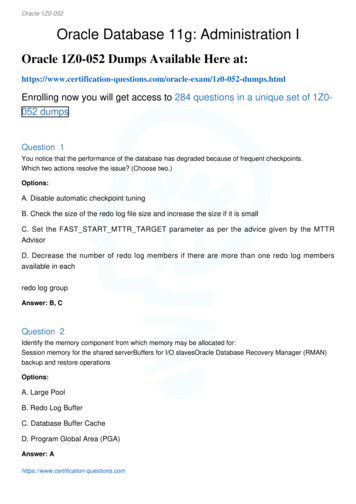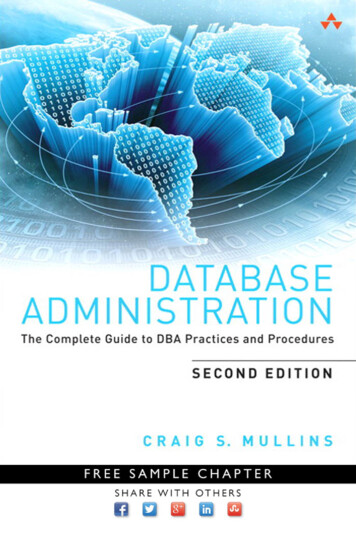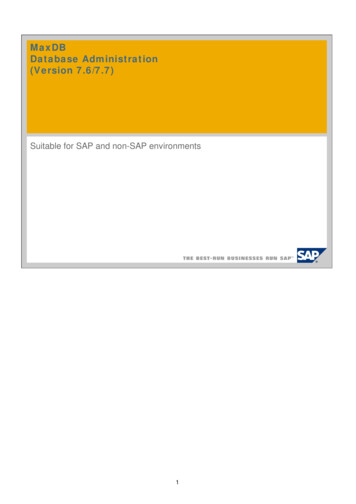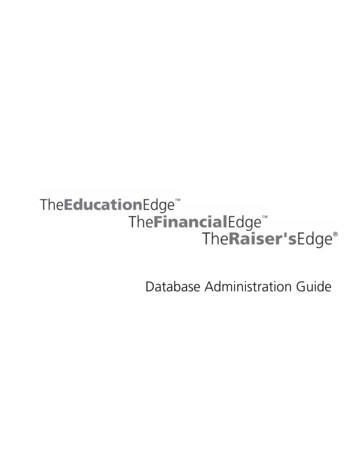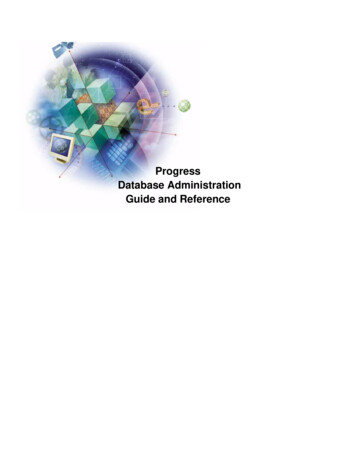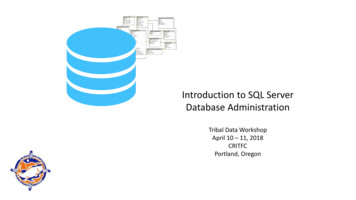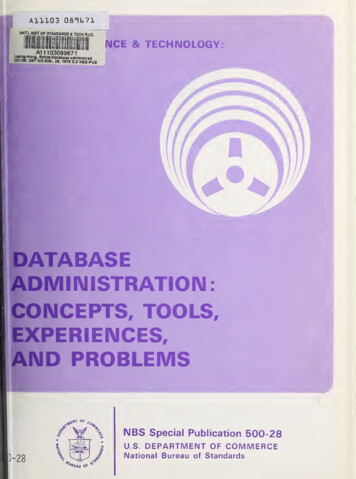
Transcription
A111D3 DflTb?!NAri INST OF STANDARDS & TECHR.I.C.A1 1103089671QC100 .U57 NO.500-,28,1978 C.2NBS-PUBDATABASEADMINISTRATION:CONCEPTS, TOOLS,EXPERIENCES,AND PROBLEMSNBSSpecial Publication500-28COMMERCEU.S. DEPARTMENT OFNational Bureau of Standardst)-28%fAUOf"
NATIONAL BUREAU OF STANDARDSThe National Bureau of Standards wasestablished by an act of Congress March 3, 1901. The Bureau's overall goal is tostrengthen and advance the Nation's science and technology and facilitate their effective application for public benefit. To thisend, the Bureau conducts research and provides: (1) a basis for the Nation's physical measurement system, (2) scientific andtechnological services for industry and government, (3) a technical basis for equity in trade, and (4) technical services to promote public safety. The Bureau consists of the Institute for Basic Standards, the Institute for Materials Research, the Institutefor Applied Technology, the Institute forOffice of ExperimentalComputer Sciences and Technology,the Office for Information Programs, and theTechnology Incentives Program.THE INSTITUTE FOR BASIC STANDARDSprovides the central basis within the United States of a complete and consistmeasurement systems of other nations; and furnishes essen-ent system of physical measurement; coordinates that system withservices leading to accurate andtialand commerce. Theuniform physical measurements throughout the Nation's scientific community, industry,Measurement Services, and the following center and divisions:Institute consists of the Office ofApplied Mathematicsoratory Astrophysics-—— Mechanics — Heat — Optical Physics — Center— Cryogenics — Electromagnetics'' — Time and Frequency'.Electricityfor Radiation Research— Lab-THE INSTITUTE FOR MATERIALS RESEARCHconducts materials research leading to improved methods of measurement, standards, and data on the properties of well-characterized materials needed by industry, commerce, educational institutions,and Government; provides advisory and research servicesdistributes standard reference materials.Theand Water Measurement, and the followingAnalytical Chemistryto otherGovernmentInstitute consists of the Office ofagencies; and develops, produces, andStandard Reference Materials, the Office of Airdivisions:— Polymers — Metallurgy — Inorganic Materials — Reactor Radiation — Physical Chemistry.THE INSTITUTE FOR APPLIED TECHNOLOGYprovides technical services developing and promoting the use of avail-able technology; cooperates with public and private organizations in developing technological standards, codes, and test methods; and provides technical advice services,and informationtoGovernment agencies andthe public.TheInstitute consists ofthe following divisions and centers:——Standards Application and AnalysisElectronic TechnologyCenter for Consumer Product Technology: ProductSystems Analysis; Product EngineeringCenter for Building Technology: Structures, Materials, and Safety; BuildingEnvironment; Technical Evaluation and ApplicationCenter for Fire Research: Fire Science; Fire Safety Engineering.——THE INSTITUTE FOR COMPUTER SCIENCES AND TECHNOLOGYconducts research and provides technical servicesdesigned to aid Government agencies in improving cost effectiveness in the conduct of their programs through the selection,acquisition, and effective utilization of automatic data processing equipment; and serves as the principal focus wthin the executivebranch for the development of Federal standards for automatic data processing equipment, techniques, and computerlanguages.TheComputerInstitute consist of the following divisions:Services— Systems and Software — Computer Systems Engineering — Information Technology.THE OFFICE OF EXPERIMENTAL TECHNOLOGY INCENTIVES PROGRAMseeks to affect public policy and processchange in the private sector by examining and experimenting with Government policies and pracorder to identify and remove Government-related barriers and to correct inherent market imperfections that impedeto facilitate technologicaltices inthe innovation process.THE OFFICE FOR INFORMATION PROGRAMStion generated withinNBS; promotespromotes optimum dissemination andthe development of the National Standard Referenceaccessibility of scientific informa-Data System anda system of in-formation analysis centers dealing with the broader aspects of the National Measurement System; provides appropriate servicesto ensure that the NBS staff has optimum accessibility to the scientific information of the world. The Office consists of thefollowing organizational units:Office of Standard Reference— Office of Technical Publications — Library —— Office of Information— Office of International Relations.DataOffice of International StandardsActivities Headqujirters and Laboratories at Gaithersburg, Maryland, unless otherwise noted; mailing address Washington, D.C. 20234."LocatedatBoulder, Colorado 80302.,
Z 1978COMPUTER SCIENCE & TECHNOLOGY:Database Administration:Concepts, Tools, Experiences, and ProblemsBelkisLeong-HongandBeatriceMarronSystems and Software DivisionInstitute forComputer Sciences and TechnologyNational Bureau of StandardsWashington, D.C. 20234U.S.DEPARTMENT OF COMMERCE,Juanita M. Kreps, SecretaryiDr.Sidney Harman, Under SecretaryJordanJ.Baruch, Assistant Secretary for Science and TechnologyNATIONAL BUREAU OF STANDARDS,'I/, #IssuedMarch 1978Ernest Ambler, Director
Reports on Computer Science and TechnologyThe National Bureau of Standards has a special responsibility within the FederalGovernment for computer science and technology activities. The programs of theNBS Institute for Computer Sciences and Technology are designed to provide ADPstandards, guidelines, and technical advisory services to improve the effectiveness ofcomputer utilization in the Federal sector, and to perform appropriate research anddevelopmentefforts as foundation for such activitiesNBS efforts to theseries will report theseinterested specialists in theand programs. This publicationFederal computer community as well as toacademic and privateThose wishingand return the formsectors.notices of publications in this series should completeto receiveat theendof this publication.National Bureau of Standards Special Publication 500-28pages (March 1978)Nat. Bur. Stand. (U.S.), Spec. Publ. 500-28,48CODEN; XNBSAVLibrary of Congress Cataloging in Publication DataLeong-Hong,Reikis.Database administration.&(Computer sciencespecial publicationSupt. of Docs, no.:1.technology) (National Bureau of Standards500-28);C13.I0:500-28Data base management.III. Series.IV. Series:Special .05] 78-606197GOVERNMENT PRINTING OFFICEWASHINGTON:ForII.500-28.no. 500-28 [QA76.9.D3]U.S.B. A., joint author.United States. National Bureau of Standards.1978by the Superintendent of Documents, U.S. Government Printing Office, Washington, D.C. 20402Stock No. 003-003-01900-3 Price 2.20
TABLE OF CONTENTSPage1.INTRODUCTION12.DATABASE ADMINISTRATION CONCEPTS22.1Database Administration Functions32.2The Database Administrator62.2.12.2.22.2.32.2.43.Functional orientationScopeStage of implementationOrganizational PlacementTHE DATABASE ADMINISTRATION TOOLCHEST3.13.28DBMS and DED/D83.1.1 Database Management Systems3.1.2 Data Element Dictionary/Directory Systems3.1.3 DED/D Relationship to DBMS4.6777Other Database Administration 4.3Tools234.3.1 Use of DBMS and DED/D234.3.2 Use of Other Database Administration Tools. 254.4Problems254.4.1 Non-Technical Problems4.4.2 Technical Problems2526Advice275.OBSERVATIONS286.IMPLICATIONS OF DBA COMMITMENT294.56.16.2What Database AdministrationShould Do For Management30What Management MUST Do for the DBA31-iii-
FIGURES1.2.3.4.5.Government DBA's Role in Database AdministrationTasksGroup A18Government DBA's Role in Database AdministrationTasksGroup B19Government DBA's Role in Database AdministrationTasksGroup C20Government DBA's Role in Database AdministrationTasksGroup D21————Availability of Software Tools to Sample DBAPopulation 24APPENDICESAPPENDIX AAPPENDIXBAPPENDIXCAPPENDIX D————BIBLIOGRAPHY32DBA INTERVIEW OUTLINE36DATABASE ADMINISTRATION TASKSINTERVIEW OUTLINEDATABASE ADMINISTRATION TOOLSINTERVIEW OUTLINE—38—41
ACKNOWLEDGEMENTWe gratefully acknowledge the excellent cooperation ofDatabase Administrators who shared their experienceswith us for this study.theBlytheBreaultCoaleDept. of Defense-- NavyDept. of Energy (Formerly ERDA)Dept. of HEWSocial Security AdministrationR. CrellinDept. of HUDR. DykeCivil Service CommissionJ. ElyDept. of DefenseNavyI. FeldmanDept. of HUDCpt. ForneyDept. of DefenseDCECCol. GersonDept. of DefenseDCECG. HallFederal Deposit Insurance CorporationDept. of AgricultureJ. LafleyP. McGuireDept. of Commerce -- NBSDept. of Energy (Formerly ERDA)S. MikkaC. Tannenbaum Dept. of TreasuryF. ThomasDept. of Defense -- NavyMILPERCENB. WellsDept. of DefenseM. WillsDept. of AgricultureJ. YiengerFederal Power CommissionE.L.R.—————We especially appreciate the support of Dr. Dennis Fife,Chief, Computer Science Section, NBS.-V-
DATABASE ADMINISTRATION:CONCEPTS, TOOLS, EXPERIENCES, AND PROBLEMSBelkis Leong-HongandBeatrice MarronIn this report the concepts ofdatabase administration, the role of the database administrator (DBA)and computer software toolsusefulindatabase administration are described in order toassist database technologists and managers.Astudy of DBA'sin the Federal Government is detailed in terms of the functions they perform, thesoftware tools they use, the problems they haveencountered, and advice they offer.Finally, someguidelines are presented on what database administration should do for management, and what management must do for their DBA's.,Key words:Computeradministration;databasedatabase management ta element;dictionary/directory (DED/D)1.INTRODUCTIONIncreased awareness of managers that data is an organizational resource has led to a recognized need for disciplined control of all automated and non-automated data.Thisin a set of management procedures andcontrolisembodiedtechnical functions which is characterized as "database administration".Atthe present time the term database administration is applied to a conglomeration of duties andThereresponsibilities for which there exists no standard.is much interest in this emergingdiscipline,both insideand outside the Federal Government.The National Bureau of Standards(NBS)ischargedunderthe provisions of Public Law 89-306 (the Brooks Act)to assist Federal information managers intheir data processing needs.NBS assesses new developments in informationordertohelpinand computer sciences and technologies,solutions to dataotheragenciesapply technological-1-
processing problems.Severalmanagement area have focussedelement dictionary/directorymanagement systems (DBMS) [1,recent NBS studies in the dataon software tools such as data(DED/D)systems and database19,26,27].In this report, concepts and functions of databaseadministration are examined. Tools useful to the practicingdatabase administrator(DBA)and problemscommon amongDBA's are discussed.Critical needs and common pitfalls areidentified to provide guidance to the database technologist,the manager,and the new DBA.A bibliography of relevantliterature is included as Appendix A.,To gather experiential data for this study, we consultDBA'sinthe Federal Government. These DBA's were verycandid about the problems to be expected in establishing aviable database administration operation, and they providedinsight into the rewards of an effectively controlled database environment.Their cooperation is greatly appreciated.Although the sample was small and from a specialized community,the observations made are applicable to the entire database community.ed2.DATABASE ADMINISTRATION CONCEPTSDatabase administration encompasses all the technicaland management activities required for organizing, maintaining and directing the database environment.Throughout thisreport "Database"isused to mean "all of the data of theorganization which is organized and controlled using a database technology," or "a systematic methodology for the standardization and integration of data resources at an organization level" [28]. A database environment consists of:the database, as defined above,and non-automated data;including** the database administratordatabase environment;* the software tools used indata processing; and*(DBA)data,automatedthe manager oftheadministrationandthe users of the database.toolusefulIt should be noted that while a DBMS is a veryfordatabase administration, the mere usage of a DBMS doesnot constitute establishingadatabase-2-environment.
The main goals of database administration are:tooptimize usage of data in a shared database environment; toincorporate a systematic methodology for the centralizedmanagement and control of data resources; and to balanceconflicting objectives with respect to the organization'smission andthe overall economy of data handling.Amongthe key requirements for effective databaseadministrationstrong management commitment and support; technicallyare:competent staff; team participation in the database environment by DBA's, management, technical staff, and users; and awell-defined Database Master Plan. This Master Plan must bedeveloped early, and must include: plans for transition intoa database environment, for staffing, and for acquisition ofdefinition of responsibilities; andsystems and services;Significant advantagesrules and procedures for operation.that database administration can provide are:The database can be better managed, especially if thedata resources are centralized and shared;*Data independence can be accomplished via controlleddefinition, design and implementation of the database;*Data redundancy and inconsistency can bebalancing conflicting requirements;*reducedbyData integrity can be improved via standard usages,increased data reliability, and enforced security res-*tr ict ionsIncreased responsiveness to the various user communities can result from better controlled, and more upto-date data; and** Economic benefits can be derived from eliminationunnecessarily duplicative processing.ofThe degree to which database administrationshould beapplied depends on the size and complexity of the databases,and the information needs of the overall organization.However,proliferating databases, overlapping requirements,lack of data integrity, and duplication of efforts are symptoms of the need for database administration.2.1Database Administration FunctionsThere is wide agreement on the basic functions of databaseA list of tasks most commonly peradministration.formed by the DBA was compiled from the literature,andispresented below5,[4,Thislist of 37, 38].itis
representative.Database definition/ redefinition. The DBA shouldidentify and define common data elements, define therelationships between data elements and other components such as programs, files, and systems. The definition of the data elements and the data relationships should be based on a clear understanding of eachparticipating user community's requirements, as well asthe overall organization's needs.Where possible, theDBA uses a data definition language to define andstructure the database.It is also in the DBA's purview to define, review and monitor data standards.Ifthe need arises for changing and re-structuring the database, the DBA shouldinitiate this activity,andredefine the database, or any part of it to meet changing requirements.1.2. Selection and procurementThe DBA should participateintheprocesses of evaluation, selection, andprocurement of hardware, software, and services relatedto database administration.Database design/ redesign The main design activitythe design and structuring of the entire database,needs of thetaking into consideration the differingentire user community.Thisincludes design of thedata structure as seen by the application community,thestorage structure, mapping and search strategies,and access methods, as well as design of the DED/D andofsupport software for creating, maintaining, andreorganizing the database. If the need arises, redesignand restructuring activities, encompassing all the elements above are also the DBA's responsibilities.3.isincluded4. Database creation. Under this function aresuch activities as data collection, database loadingand testing, and implementation of data definitions,the DED/D and other database support software.5. Database Security/IntegrityThe database securityfunction is intended to guard against unauthorized access to the database, and unauthorized update, copying,removal or destruction of any part of the database.This may be achieved through the use of security locksandkeys, cryptography, etc. Database integrity is recorrectnessthelated to the DBA's responsibility forIt can be achieved throughandaccuracy of the data.backupdumps,the use of validation checks, loggings,and recovery procedures and auditing procedures.,
6. Database maintenance/management. The DBAshould beresponsible for the continued well-being of the database environment.As such, it is his responsibility tomaintain and update database definitions and databasedocumentation, and to maintain and update the DED/D andother database support software.The DBA should interpret and administer high level management policies related to the database, and define rules of use and access constraints for the database.Inaddition,heshould be responsible for review, and approval of newdata definitions and enforcement of data standards.7. Database performance monitoring and evaluationResponsibilities should include reviewing, test ing andevaluating the performance of automated as well as procedural data activities; initiation of system improveassessment of the impact ofment when indicated;changes; and maintenance of state-of-the-art awareness.If the performance evaluation and monitoring activitiesindicate that the database is no longer effective orefficient in the present configuration,redefinition,redesign, and restructuring activities may be undertak.,en.8. Database enforcementEnforcement activities includedetermination of compliance with established standardorganization,usages; development of database content,andstorage control procedures; and responsibility forsuch asaccess control and security of the database,password issuance.with systems and application9. Liaison with users,and with organizational management shouldanalysts,provide information, assistance and guidance on the usefacilities,todetect and correct userof databaseproblems, and to notify users of changes in systemstatus10Training of users, staff and management should becoordinated to develop awareness of database concepts,and available resources.There is another category of functions which is typically performed before the database environment is operational. This category of initiation functions includes suchactivities as planning, formulating a Database Master Plan,andperforming feasibility studies, personnel staffing,negotiating participation in the database environment withdifferent groups of users.-5-
2.2The Database AdministratorThe DBA, in theory, isthe organization'sleaderinplanning, design, development, implementation, testing, documentation, operation, and maintenance of the entire database environment.The role of the DBA is usually characterized as both technical and administrative. There isalso apromotional dimension to this role, since the DBA representsthe database administration concepts and procedurestoallparticipants, and coordinates all database activities amongmanagers, analysts, systems and application programmers, andBecause database administration activities impactusers.across organizational boundaries, the DBA position is sensitive, and the DBA must be astute to jurisdictional questionsand competing mission requirem
A111D3DflTb?! NAriINSTOFSTANDARDS&TECH R.I.C. A11103089671 QC100.U57NO.500-,28,1978C.2NBS-PUB DATABASE ADMINISTRATION
